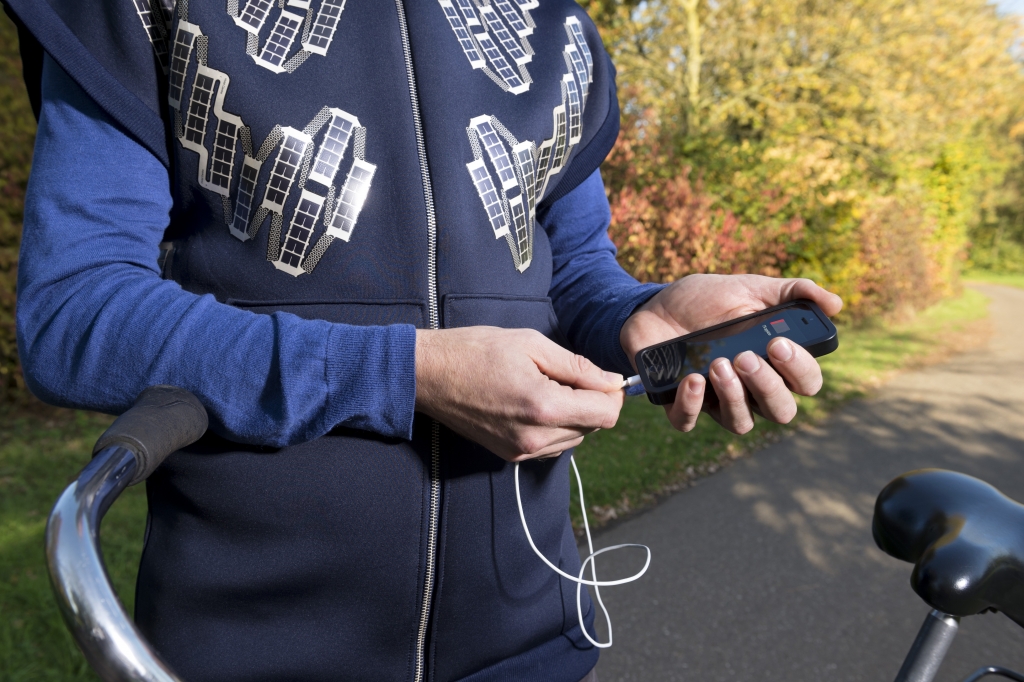“Technology is not a mere tool, but rather one of aesthetics.”
Dutch fashion designer Pauline van Dongen outlines this philosophy on her website, emphasizing the value and meaning that technology can bring to fashion. “It’s never about technology for technology’s sake,” the statement reads. Nevertheless, technology is what stands out the most about van Dongen’s apparel, blending distinctive fashion statements with deliberate elements of convenience and function.
“Technology is not a mere tool, but rather one of aesthetics.”
Dutch fashion designer Pauline van Dongen outlines this philosophy on her website, emphasizing the value and meaning that technology can bring to fashion. “It’s never about technology for technology’s sake,” the statement reads. Nevertheless, technology is what stands out the most about van Dongen’s apparel, blending distinctive fashion statements with deliberate elements of convenience and function.
You certainly wouldn’t find styles like hers at Macy’s. From FysioPal – a top for improving posture that vibrates when the wearer slouches – to Skynfeel – a bodysuit designed to maximize airtime for long jumpers – her designs are adventurous and purposeful. Vigour is a cardigan that utilizes stretch sensors to monitor upper body movements in geriatric patients; an accompanying app gives data to the wearer and his or her physical therapist on the patient’s movements throughout the day. Mesopic and Phototrope emit light to keep night runners safe.
Advertisement
 Van Dongen’s solar collection is a little closer to “everyday” wear. By integrating thin-film photovoltaic cells, her line of jackets, dresses, and shirts allows the wearer to charge their smartphones and other mobile devices via USB cable. For example, the Solar Shirt prototype produces roughly 1 watt of electricity in bright sunlight – enough to charge a phone for a few hours. Indoors, the shirt produces enough wattage to keep a device charged. It can also store electricity in a battery pack for later use, and it’s washable.
Van Dongen’s solar collection is a little closer to “everyday” wear. By integrating thin-film photovoltaic cells, her line of jackets, dresses, and shirts allows the wearer to charge their smartphones and other mobile devices via USB cable. For example, the Solar Shirt prototype produces roughly 1 watt of electricity in bright sunlight – enough to charge a phone for a few hours. Indoors, the shirt produces enough wattage to keep a device charged. It can also store electricity in a battery pack for later use, and it’s washable.
Collaboration Is Key
The photovoltaic cell modules for the Solar Shirt were developed by Holst Centre, a research center dedicated to innovation in the field of flexible electronics. Margreet de Kok, senior scientist, stresses the company’s emphasis on open collaboration: “Our partners – for instance, material suppliers and users – join forces in a pre-competitive state,” she says. It’s a unique environment that encourages the flow of ideas.
For the Solar Shirt project, the van Dongen-Holst partnership was a perfect example of how open collaboration can bring out the best in all parties involved. “We develop technology, and to the best of our expertise, we try to imagine what this technology can bring in application,” says de Kok. “But the design of it, we realize, is not our cup of tea.” That’s where van Dongen came in.
The Solar Shirt serves as a showpiece to demonstrate both the possibilities enabled by such collaboration as well as the capabilities of thin-film electronics in fashion. De Kok says it’s not quite ready for the commercial market yet – and that wasn’t the goal for this project – although new improvements are being made every day.
One roadblock to commercial adoption is simply the cost of production and materials. At Holst Centre, the modules begin as a roll of thermoplastic polyurethane (TPU). A Dek Horizon 03i roll-to-roll screen printer deposits DuPont 5025 silver conductor on top; a number of components follow, including an isotropic conductive adhesive from Henkel and the photovoltaic modules themselves. Another layer of TPU is placed on top to seal everything together. The modules can then be laser- or die-cut in the shape of the desired element and heat-pressed onto fabric. This process lends itself perfectly to a mass manufacturing model, but it’s not without its complexities – ones that add up in price.
Holst Centre is working to improve the technology by making it more stretchable and flexible. The problem lies mainly in the photovoltaic modules themselves, which to date aren’t stretchable. Rubber would be a preferable base material to plastic for a number of reasons – it’s more conformable and “textile-like,” says de Kok – but to date it’s not possible. If manufacturers could print directly onto rubber, this would also drastically simplify the production process and, again, the cost.
Advertisement
To the non-expert, the seemingly obvious question is: Why can’t they just print right onto the textile? If it works for T-shirts, shouldn’t it work for printed electronics?
“It’s certainly feasible,” de Kok says, but it’s not that simple. The problem is that textiles have a very open structure – that’s what we love about them. They’re breathable, flexible, foldable, and lightweight. But electronics require a continuous, uninterrupted layer in order to actually conduct electricity and function. De Kok says this leaves researchers two options: close up the structure of the textile (via flaps on the surface, for instance), or “manipulate the surface tension energies of the textile in such a way that the
electronics will stay on top.”
Redefining Fashion
Despite its challenges, the Solar Shirt is unique in both the printed electronics and fashion worlds. “To date, all attempts to combine solar technology and fashion had focused on one-off, haute couture designs,” van Dongen says in a release. “We were able to seamlessly integrate the technology and the design so they mutually inform each other – advancing the concept and value of fashion. We’ve taken solar fashion from the catwalk to the high street.”

Pauline van Dongen’s designs combine fashion and function for an avant-garde look that comes in handy when you’re on the go. This Solar Shirt prototype was designed with photovoltaic cells from Holst Centre. Images courtesy of Holst Centre.
The potential for customization is encouraging, as well. Ton van Mol, Holst Centre managing director, says the modular ability of the roll-to-roll production gives designers “complete freedom.”
What’s next? De Kok says a large focus at Holst Centre right now is integrating organic and inorganic components to achieve the best of both worlds. Such products would then have both excellent conductivity as well as the rigidity to survive mechanical impacts. Possible applications range from medical imaging to car dashboards and more.
Advertisement
Van Dongen has her sights set beyond the realm of the smartphone. In a recent blog post, she quotes Syuzi Pakhchyan, a thought leader in the wearable technology world: “Our body is not a smartphone.” Pakhchyan sat on a panel with van Dongen at the recent South by Southwest festival in Austin, Texas. “There are so many more interesting, engaging, and subtler ways in which we can interface with and through our bodies,” the blog post continues, reminding readers of the importance of the human wearing the wearables. “Let’s replace ‘What does it do’ with ‘What does it incite us to do?’”
Check out other Print Tech reads, or explore more from Screen Printing‘s April/May 2017 issue.


 Art, Ad, or Alchemy1 month ago
Art, Ad, or Alchemy1 month ago
 Case Studies1 month ago
Case Studies1 month ago
 Andy MacDougall1 month ago
Andy MacDougall1 month ago
 Editor's Note2 weeks ago
Editor's Note2 weeks ago
 Columns2 weeks ago
Columns2 weeks ago
 Thomas Trimingham2 months ago
Thomas Trimingham2 months ago
 Marshall Atkinson2 weeks ago
Marshall Atkinson2 weeks ago
 News & Trends1 month ago
News & Trends1 month ago
 Van Dongen’s solar collection is a little closer to “everyday” wear. By integrating thin-film photovoltaic cells, her line of jackets, dresses, and shirts allows the wearer to charge their smartphones and other mobile devices via USB cable. For example, the Solar Shirt prototype produces roughly 1 watt of electricity in bright sunlight – enough to charge a phone for a few hours. Indoors, the shirt produces enough wattage to keep a device charged. It can also store electricity in a battery pack for later use, and it’s washable.
Van Dongen’s solar collection is a little closer to “everyday” wear. By integrating thin-film photovoltaic cells, her line of jackets, dresses, and shirts allows the wearer to charge their smartphones and other mobile devices via USB cable. For example, the Solar Shirt prototype produces roughly 1 watt of electricity in bright sunlight – enough to charge a phone for a few hours. Indoors, the shirt produces enough wattage to keep a device charged. It can also store electricity in a battery pack for later use, and it’s washable.















